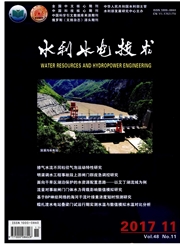

 中文摘要:
中文摘要:
根据工程地质条件,基于卸荷岩体理论对锦屏二级水电站地下洞室进行开挖数值模拟计算,以桩号厂右0+000.0剖面为主要研究对象,结合变形监测资料进行卸荷区的划分,分析围岩在开挖、卸荷及加固各工况下的塑性区演化过程。数值计算结果表明,监测点的监测位移与计算位移吻合情况较好。以主厂房第二步开挖全过程为例,开挖工况下围岩强卸荷区出现的塑性区在卸荷工况下进一步扩大,而在锚索加固完成后,塑性区基本消失。这说明强弱卸荷区的划分较为合理,建立的模型适当,设计锚固方案有效可行。
 英文摘要:
英文摘要:
According to the engineering geological conditions, a numerical simulation is made on a large sized underground chamber based on the unloading rock mass theory, in which the section at the stake number of 0 + 000. 0 at the right side of the power house in Jinping Ⅱ Hydropower Station is taken as the main study object, and then the unloading area is zoned according to the relevant deformation monitoring data, while the evolution process of the plastic zone of the surrounding rock is analyzed as well The numerical calculation result shows that the monitored displacement and the calculated displacement at the monitoring point are better coincided, h is known, by taken the whole process of the second step excavation of the main power house as the study case, that the plastic zone where the strong unloading area of the surrounding rock occurs under excavation is further enlarged however, the plastic zone basically disappears after the completion of the strengthening with anchoring cable. It is indicated that not only the zoning between both the weak and strong unloading areas is more reasonable, but the establishment of the model is also adaptable, thus the design scheme of anchorage strengthening is effective and feasible.
 同期刊论文项目
同期刊论文项目
 同项目期刊论文
同项目期刊论文
 期刊信息
期刊信息
